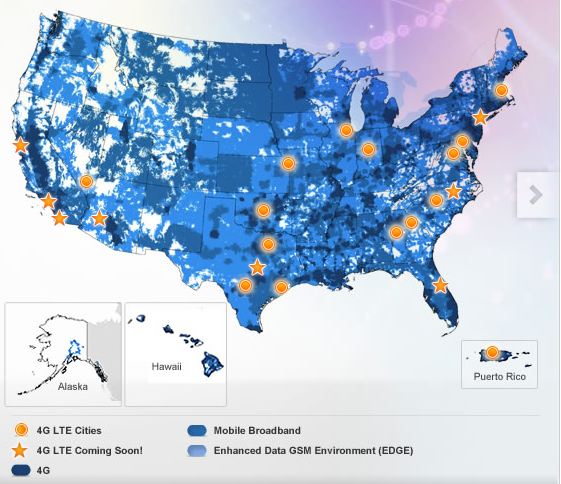AT&T lights up 4G LTE service in 11 more cities and mine is one of them

AT&T LTE is now available in San Diego, which means I'll soon conduct speed test comparisons around the city against Verizon's 4G network. It will be the Wilcox household network speed test face-off, the wife's Samsung Galaxy S II Skyrocket against my Galaxy Nexus.
San Diego joins 10 other cities, which LTE service AT&T announced today. They are: Austin, Texas; Chapel Hill, N.C.; New York City metro area; Los Angeles; Oakland; Orlando, Phoenix; Raleigh, N.C.; San Diego; San Francisco; and San Jose. They join 15 others: Athens, Ga.; Atlanta; Baltimore; Boston; Charlotte, N.C.; Chicago; Dallas-Fort Worth; Houston; Indianapolis; Kansas City; Las Vegas; Oklahoma City; San Antonio; San Juan, Puerto Rico; and Washington, DC. AT&T claims its LTE network reaches 74 million people; Verizon, 200 million.
"We’re building a 4G LTE network that’s blazing fast, and we offer dual layers of 4G technologies to provide customers with a more consistent speed experience" John Stankey, AT&T Business Solutions CEO, says. "Our network, together with our unsurpassed 4G device portfolio and innovative applications, will give our customers an industry-leading mobile broadband experience".
AT&T's network expansion trails far behind Verizon's, and the nation's second-largest carrier doesn't expect to complete its LTE rollout until 2013. AT&T offers just two LTE phones, HTC Vivid and Skyrocket, while Verizon offers nine. All 11 are Androids.
Days before Apple announced iPhone 4S, I asked: "What if iPhone 5 isn't LTE?" There is no true 4G iPhone, which apparently isn't stopping buyers. Yesterday Verizon -- the carrier with broadest LTE network and most number of supporting handsets -- revealed 4.2 million iPhones sold during fourth quarter.
Circling back to LTE here in San Diego, last week I wrote about sudden battery problems with Skyrocket, apparently related to network acquisition problems. I suspected that the phone burns through the battery trying to connect to AT&T's cellular network. An AT&T technician confirmed an acquisition problem, but attributed it to the antenna. I wasn't convinced, particularly since AT&T will only swap the fairly new Skyrocket for a refurbished one.
I discussed the situation with my wife and asked her to sit tight, thinking the problem might resolve itself. I had seen this before. In late Spring 2010, battery life went to hell on all our AT&T phones, and I determined it was a problem connecting to the local cellular towers. About 30 days later, battery life on all phones returned to normal and we stopped having dropped calls. AT&T had been updating the network in advance of iPhone 4's release.
AT&T had indicated LTE would soon come to San Diego, and I wondered if a network upgrade could cause the problem. Three days ago, Skyrocket went from 8-10 hours battery life, even when idle, to more than 24. It's nowhere as good as when I bought the phone in early November but more than acceptable. My wife is out as I write, or I'd check to see if she's connected to LTE. But that's what I expect, and I am looking forward to speed comparisons. Best speed test so far on Verizon, about two blocks from my apartment: 27Mbps. Can AT&T do better? I actually expect it will. But, so far, Galaxy Nexus, which is always connected to LTE, has exceptional battery life. Galaxy S II Skyrocket won't easily compete.
